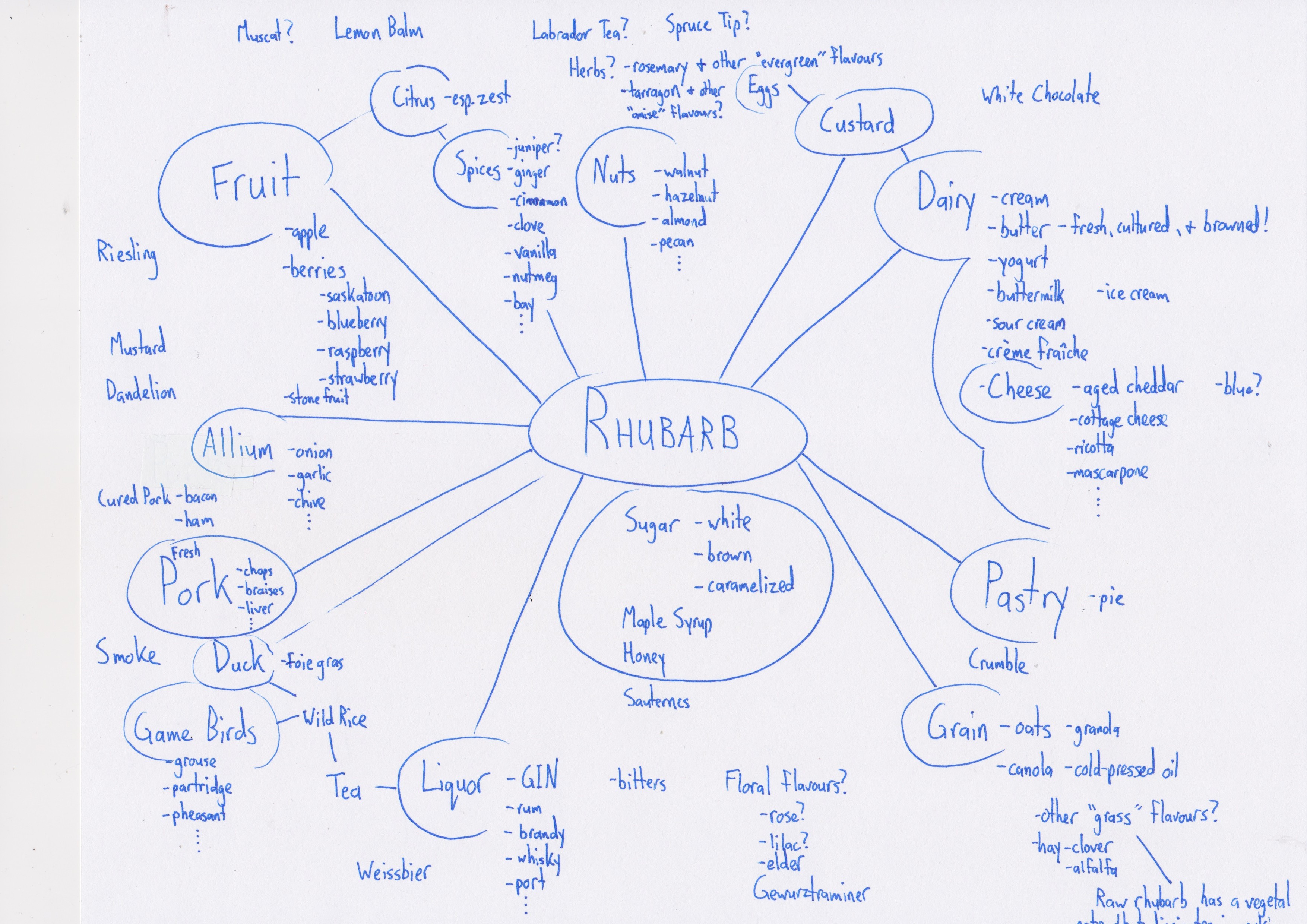One day I was bored so I made this drawing. It contains some thoughts on the flavour of rhubarb, with the intent of deepening our appreciation of the plant, and broadening its culinary application.
 Rhubarb is almost always cooked with a sweetener to balance the sharp acidity of the plant. Brown sugar deserves special mention. Honey also works well, which has me wondering if Sauternes would pair well with a rhubarb dish.
Rhubarb is almost always cooked with a sweetener to balance the sharp acidity of the plant. Brown sugar deserves special mention. Honey also works well, which has me wondering if Sauternes would pair well with a rhubarb dish.
Most forms of dairy, whether sweet or cultured, pair well with rhubarb. Rich dairy tempers the acidity of rhubarb. Ice cream is especially good at this. Salty dairy like aged cheddar can be a good counterpoint to rhubarb’s bright acidity.
Eggs work surprisingly well with rhubarb. Picture a poached egg served on a bed of dandelion greens dressed with rhubarb vinaigrette. Once again we have a rich, fatty substance (the egg yolk) tempering the acidity. The subtle sulfur taste of eggs matches rhubarb somehow, too.
Where eggs and dairy meet there is custard. Custard is a near perfect partner for rhubarb, especially when made with lots of butter and flavoured with vanilla.
We’ve all had rhubarb crumble, which suggests that rhubarb goes well with grains like wheat and oats. I often add cold-pressed canola to my crumbles to reinforce the natural grassy taste of the oats. The next time you have a chance to eat raw rhubarb, see if you can pick up its distinctive vegetal flavour. This “green” component completely dissipates with cooking, but I imagine there are ways to bring it back. Picture steaming a ham with generous fistfuls of clover and alfalfa, then eating the meat with rhubarb jam.
Nuts, another common ingredient in crumbles, go well with rhubarb. Spices, too. A piece of cinnamon is most welcome in stewed rhubarb. My grandma’s rhubarb relish was infused with cinnamon, clove, allspice, and black pepper. Ginger is a classical partner for rhubarb in the United Kingdom, usually in the form of rhubarb ginger jelly. And we’ve already mentioned vanilla, especially in custards and creams.
I don’t often cook rhubarb with herbs, but I bet there are some interesting combinations. The anise-type herbs like tarragon and chervil come to mind (think: rhubarb tarragon sorbet). Also I’d bet that the evergreen flavours of juniper, rosemary, spruce tips, and labrador tea could also work, especially in cocktails (NB Three Boars, Woodwork, et al).
Citrus is a friend to rhubarb, but rhubarb is so sour that it doesn’t need the juice of lemons or limes: zest is best. I always smell candied lemon or lemon balm in muscat wines like Moscato d’Asti. I bet there’s a good pairing with rhubarb to be had.
Of course rhubarb is often used in conjunction with other fruit. The secondary fruit tempers the acidity of the rhubarb, and the rhubarb adds punch and volume. I don’t typically use rhubarb with fruit that is already tart, like raspberry. I prefer low-acid fruit with mellow flavours. Ambrosia apples with their honey aroma come to mind. I’ve written about the felicitous connection between saskatoons and rhubarb here.
I often think of allium as a bridge between sweet and savoury. Cooked onions and garlic are already a pleasing balance of the two, so they can easily be used to link the flavours of, say, fruit and meat.
Pork and rhubarb was a common pairing when my father was little. Cured meat like bacon and ham work the same magic as the aged cheddar mentioned above. Ducks and game birds like pheasant and grouse are a good fit, too.
Raw allium can be nice in moderation. Something like chive blossom works better than, say, red onion. The very bottom left corner of the flavour web may seem weird. I’ve written this before, but to me wild rice smells almost identical to rooibos tea. I know rhubarb goes well with tea (see rhubarb iced tea), and so I’m pretty sure rhubarb would go well with wild rice.
Some of the liquor pairings are no-brainers. I’ve already posited that rhubarb goes well with evergreen flavours, so gin should work. Rhubarb and brown sugar and vanilla are all friends, so oak-aged spirits like fine rum and brandy and bourbon also fit. If rhubarb goes well with the smoky flavour of ham and bacon, I wonder if there is a good smoky scotch pairing out there (NB Three Boars, Woodwork, et al).
In Italy rhubarb is used to make bitter aperitifs like Zucca and Aperol.
Speaking of drinks, Weissbier popped into my head as a good match for rhubarb because of its clove and citrus aromas. Maybe that’s what to drink with the dandelion, poached egg, rhubarb dish I mentioned above.
I’m pretty confident in the strength of the rhubarb-floral connection. In Austria I ate an elderberry flower fritter dusted with sugar and dipped in rhubarb compote. I bet some fancy desserts could be concocted with rhubarb and rose water, or rhubarb and candied lilac. To me this suggests that rhubarb might pair well with floral wines like Gewurztraminer.
Thoughts on the flavour of rhubarb? Corrections? Additions?